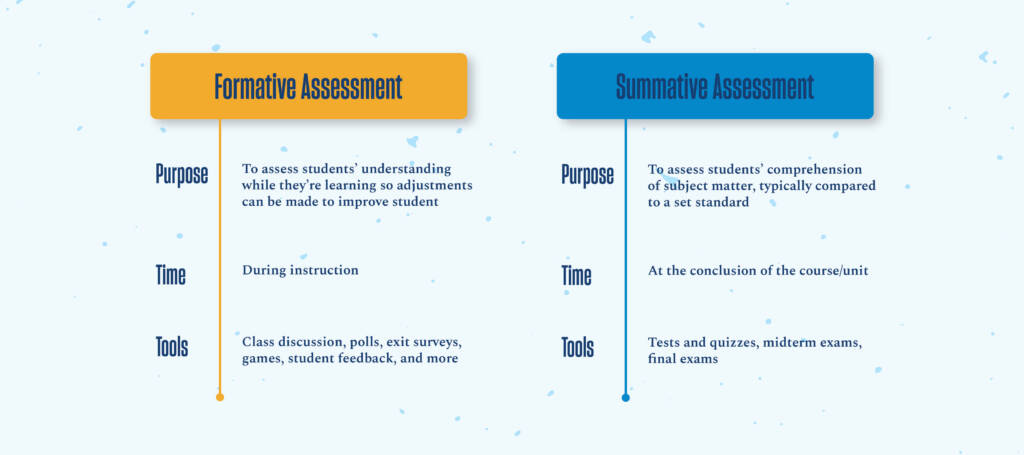

Traditional student assessment typically comes in the form of a test, pop quiz, or more thorough final exam. But as many teachers will tell you, these rarely tell the whole story or accurately determine just how well a student has learned a concept or lesson.
That’s why many teachers are utilizing formative assessments. While formative assessment is not necessarily a new tool, it is becoming increasingly popular amongst K-12 educators across all subject levels.
Curious? Read on to learn more about types of formative assessment and where you can access additional resources to help you incorporate this new evaluation style into your classroom.
Online education glossary EdGlossary defines formative assessment as “a wide variety of methods that teachers use to conduct in-process evaluations of student comprehension, learning needs, and academic progress during a lesson, unit, or course.” They continue, “formative assessments help teachers identify concepts that students are struggling to understand, skills they are having difficulty acquiring, or learning standards they have not yet achieved so that adjustments can be made to lessons, instructional techniques, and academic support.”
The primary reason educators utilize formative assessment, and its primary goal, is to measure a student’s understanding while instruction is happening. Formative assessments allow teachers to collect lots of information about a student’s comprehension while they’re learning, which in turn allows them to make adjustments and improvements in the moment. And, the results speak for themselves — formative assessment has been proven to be highly effective in raising the level of student attainment, increasing equity of student outcomes, and improving students’ ability to learn, according to a study from the Organization for Economic Co-operation and Development (OECD).
On the flipside of the assessment coin is summative assessments, which are what we typically use to evaluate student learning. Summative assessments are used after a specific instructional period, such as at the end of a unit, course, semester, or even school year. As learning and formative assessment expert Paul Black puts it, “when the cook tastes the soup, that’s formative assessment. When a customer tastes the soup, that’s summative assessment.”

There are many types of formative assessment tools and strategies available to teachers, and it’s even possible to come up with your own. However, here are some of the most popular and useful formative assessments being used today.
Students break out into small groups and are given a blank chart and writing utensils. In these groups, everyone answers an open-ended question about the current lesson. Beyond the question, students can also add any relevant knowledge they have about the topic to their chart. These charts then rotate from group to group, with each group adding their input. Once everyone has written on every chart, the class regroups and discusses the responses.
This formative assessment style is quite flexible and can be used in many different settings. You can ask individuals, groups, or the whole class high-level, open-ended questions that start with “why” or “how.” These questions have a two-fold purpose — to gauge how well students are grasping the lesson at hand and to spark a discussion about the topic.
These written summaries of a lesson or subject ask students to complete three separate write-ups of varying lengths: short (10-15 words), medium (30-50 words), and long (75-100). These different lengths test students’ ability to condense everything they’ve learned into a concise statement, or elaborate with more detail. This will demonstrate to you, the teacher, just how much they have learned, and it will also identify any learning gaps.
Think-pair-share asks students to write down their answers to a question posed by the teacher. When they’re done, they break off into pairs and share their answers and discuss. You can then move around the room, dropping in on discussions and getting an idea of how well students are understanding.
Looking for a competitive edge? Explore our Education certificate options today! >
This formative assessment tool can be written or oral and asks students to respond to three very simple prompts: Name three things you didn’t know before, name two things that surprised you about this topic, and name one you want to start doing with what you’ve learned. The exact questions are flexible and can be tailored to whatever unit or lesson you are teaching.
This is a great participation tool to use mid-lesson. At any point, pose a poll question to students and ask them to respond by raising their hand. If you have the capability, you can also use online polling platforms and let students submit their answers on their Chromebooks, tablets, or other devices.
Exit and admission tickets are quick written exercises that assess a student’s comprehension of a single day’s lesson. As the name suggests, exit tickets are short written summaries of what students learned in class that day, while admission tickets can be performed as short homework assignments that are handed in as students arrive to class.
This quick, formative assessment tool is most useful at the end of the day to get a complete picture of the classes’ learning that day. Put one minute on the clock and pose a question to students about the primary subject for the day. Typical questions might be:
These types of assessments are likely already part of your evaluation strategy and include projects like posters and collage, skit performances, dioramas, keynote presentations, and more. Formative assessments like these allow students to use more creative parts of their skillset to demonstrate their understanding and comprehension and can be an opportunity for individual or group work.
Dipsticks — named after the quick and easy tool we use to check our car’s oil levels — refer to a number of fast, formative assessment tools. These are most effective immediately after giving students feedback and allowing them to practice said skills. Many of the assessments on this list fall into the dipstick categories, but additional options include writing a letter explaining the concepts covered or drawing a sketch to visually represent the topic.
A majority of students enjoy games of some kind, and incorporating games that test a student’s recall and subject aptitude are a great way to make formative assessment more fun. These could be Jeopardy-like games that you can tailor around a specific topic, or even an online platform that leverages your own lessons. But no matter what game you choose, these are often a big hit with students.
Interview-based assessments are a great way to get first-hand insight into student comprehension of a subject. You can break out into one-on-one sessions with students, or allow them to conduct interviews in small groups. These should be quick, casual conversations that go over the biggest takeaways from your lesson. If you want to provide structure to student conversations, let them try the TAG feedback method — tell your peer something they did well, ask a thoughtful question, and give a positive suggestion.
Allow students to take the rubric you use to perform a self assessment of their knowledge or understanding of a topic. Not only will it allow them to reflect on their own work, but it will also very clearly demonstrate the gaps they need filled in. Self assessments should also allow students to highlight where they feel their strengths are so the feedback isn’t entirely negative.
Participation cards are a great tool you can use on-the-fly in the middle of a lesson to get a quick read on the entire classes’ level of understanding. Give each student three participation cards — “I agree,” “I disagree,” and “I don’t know how to respond” — and pose questions that they can then respond to with those cards. This will give you a quick gauge of what concepts need more coverage.
The education industry is always changing and evolving, perhaps now more than ever. Learn how you can be prepared by downloading our eBook.